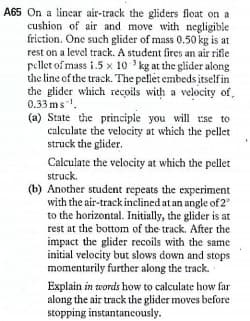A65 On a linear air-track the gliders float on a cushion of air and move with negligible friction. One such glider of mass 0.50 kg is at rest on a level track. A student fires an air rifle pellet of mass i.5 x 10 kg at the glider along the line of the track. The pellet embeds itself in the glider which recoils with a velocity of, 0.33 ms. (a) State the principle you will se to calculate the velocity at which the pellet struck the glider. Calculate the velocity at which the pellet struck.
A65 On a linear air-track the gliders float on a cushion of air and move with negligible friction. One such glider of mass 0.50 kg is at rest on a level track. A student fires an air rifle pellet of mass i.5 x 10 kg at the glider along the line of the track. The pellet embeds itself in the glider which recoils with a velocity of, 0.33 ms. (a) State the principle you will se to calculate the velocity at which the pellet struck the glider. Calculate the velocity at which the pellet struck.
Elements Of Electromagnetics
7th Edition
ISBN:9780190698614
Author:Sadiku, Matthew N. O.
Publisher:Sadiku, Matthew N. O.
ChapterMA: Math Assessment
Section: Chapter Questions
Problem 1.1MA
Related questions
Question
Show all working explaining detailly each step.
![Calculate how far the glider moves along
the air track before stopping momentarily.
[0 & C, "92]](/v2/_next/image?url=https%3A%2F%2Fcontent.bartleby.com%2Fqna-images%2Fquestion%2F5a6d9c67-6f13-49d2-ac4d-2d996f90a88b%2Fde0b376c-3d1d-41bb-8096-6360b9d5aa2d%2Fxw3va8m_processed.jpeg&w=3840&q=75)
Transcribed Image Text:Calculate how far the glider moves along
the air track before stopping momentarily.
[0 & C, "92]

Transcribed Image Text:A65 On a linear air-track the gliders fioat on a
cushion of air and move with negligible
friction. One such glider of mass 0.50 kg is at
rest on a level track. A student fires an air rifle
pellet of mass i.5 x 10 'kg at the glider along
the line of the track. The pellet embeds itself in
the glider which recoils with a velocity of,
0.33 ms.
(a) State the principle you will t:se to
calculate the velocity at which the pellet
struck the glider.
Calculate the velocity at which the pellet
struck.
(b) Another student repeats the experiment
with the air-track inclined at an angle of 2
to the horizontal. Initially, the glider is at
rest at the bottom of the track. After the
impact the glider recoils with the same
initial velocity but slows down and stops
momentarily further along the track.
Explain in words how to calculate how far
along the air track the glider moves before
stopping instantancously.
Expert Solution
This question has been solved!
Explore an expertly crafted, step-by-step solution for a thorough understanding of key concepts.
Step by step
Solved in 2 steps

Knowledge Booster
Learn more about
Need a deep-dive on the concept behind this application? Look no further. Learn more about this topic, mechanical-engineering and related others by exploring similar questions and additional content below.Recommended textbooks for you

Elements Of Electromagnetics
Mechanical Engineering
ISBN:
9780190698614
Author:
Sadiku, Matthew N. O.
Publisher:
Oxford University Press

Mechanics of Materials (10th Edition)
Mechanical Engineering
ISBN:
9780134319650
Author:
Russell C. Hibbeler
Publisher:
PEARSON

Thermodynamics: An Engineering Approach
Mechanical Engineering
ISBN:
9781259822674
Author:
Yunus A. Cengel Dr., Michael A. Boles
Publisher:
McGraw-Hill Education

Elements Of Electromagnetics
Mechanical Engineering
ISBN:
9780190698614
Author:
Sadiku, Matthew N. O.
Publisher:
Oxford University Press

Mechanics of Materials (10th Edition)
Mechanical Engineering
ISBN:
9780134319650
Author:
Russell C. Hibbeler
Publisher:
PEARSON

Thermodynamics: An Engineering Approach
Mechanical Engineering
ISBN:
9781259822674
Author:
Yunus A. Cengel Dr., Michael A. Boles
Publisher:
McGraw-Hill Education

Control Systems Engineering
Mechanical Engineering
ISBN:
9781118170519
Author:
Norman S. Nise
Publisher:
WILEY

Mechanics of Materials (MindTap Course List)
Mechanical Engineering
ISBN:
9781337093347
Author:
Barry J. Goodno, James M. Gere
Publisher:
Cengage Learning

Engineering Mechanics: Statics
Mechanical Engineering
ISBN:
9781118807330
Author:
James L. Meriam, L. G. Kraige, J. N. Bolton
Publisher:
WILEY